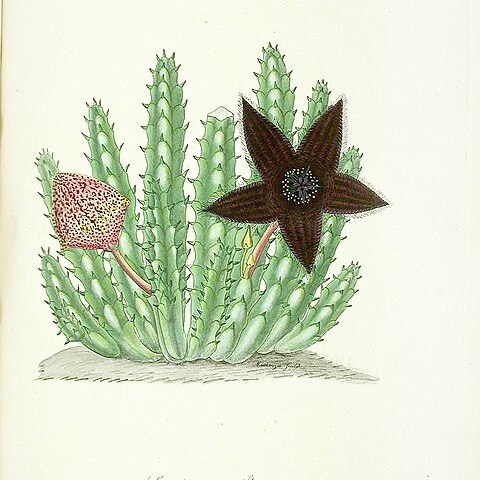Perennial succulent; stems decumbent, 60-110 mm long, obtusely 4-angled, softly fleshy, glabrous, grey-green, teeth ending in spreading leaves. Inflorescence 1 per stem, arising near base of stem with 1-4 flowers developing in succession. Calyx glabrous, ovate-lanceolate. Corolla spreading, with shallow, funnel-shaped depression in centre, glabrous, margins ciliate, inside blackish purple with lighter purple and/or yellow markings, outside pale green with brown-red markings. Corona blackish purple, arising from staminal column, glabrous; outer corona of 5 ascending to spreading lobes, deeply trifid lobes; inner lobes 2-horned, with yellow markings. Flowering time Oct.-Mar. Follicles fusiform, beaked, green mottled with darker green markings, glabrous.
Clump-forming, glabrous succulent, up to 150 mm x 1 m, stems 4-angled, tuberculate, up to 15 mm diam., with 5-10 mm long, finely-pointed rudimentary leaves. Flowers 1-3, developing successively near base of stem, on a peduncle up to 20 mm long, pedicels 30-50 mm long. Corolla rotate, 45-100 mm diam., inside densely papillate-rugulose and glabrous, purple-black, with yellow mottling, tube shallow, lobes spreading, deltate, 20-35 x 20-30 mm, with marginal cilia. Corona yellow mottled with purple, outer lobes deeply trifid, spreading, 7-8 mm long, inner adpressed to anthers then recurved and terete above, with a dorsal horn.
Perennial herb, clumps up to 500 mm wide. Stems succulent, 50-150 x 10-15 mm. Leaves: rudiments 5-10 mm long. Flowers: pedicels short, 10-20(-40) mm long; corona lobes deeply 3-dentate, inner lobes 2-horned, yellow, marked with dark purple; corolla lobes prominently ciliate, 45-100 mm wide, rotate, green outside, purple-spotted brownish towards apex of lobes, inside dark brown to almost black or purple-black, with scattered, small, irregular, yellowish or buff markings; Oct.-May. Fruit a follicle.
Succulent perennial herb, up to ± 70 mm tall. Leaves large, up to 10 mm long. Pedicels short, 10-20 mm (rarely up to 40 mm) long. Corolla lobes prominently ciliate. Outer corona lobes deeply 3-dentate, inner lobes 2-horned. Flowers green outside, purple-spotted, brownish towards apex of lobes, inside dark brown to almost black or purple-black with scattered small irregular yellowish or buff markings.
Small succulent forming clumps to 1 m diam., with erect stems 10-15 mm diam., 4-angled; sap clear. Leaves minute, linear, caducous. Flowers 45-100 mm diam., purple-black often finely speckled with yellow.

